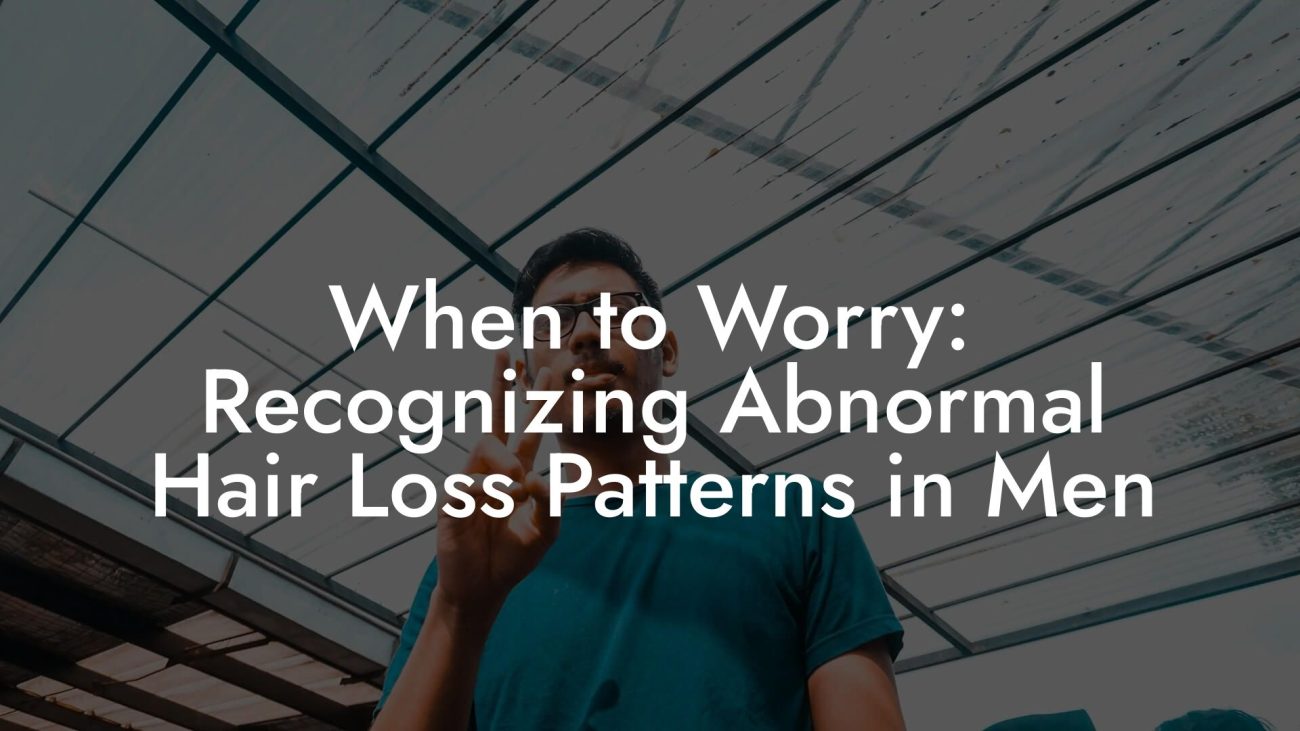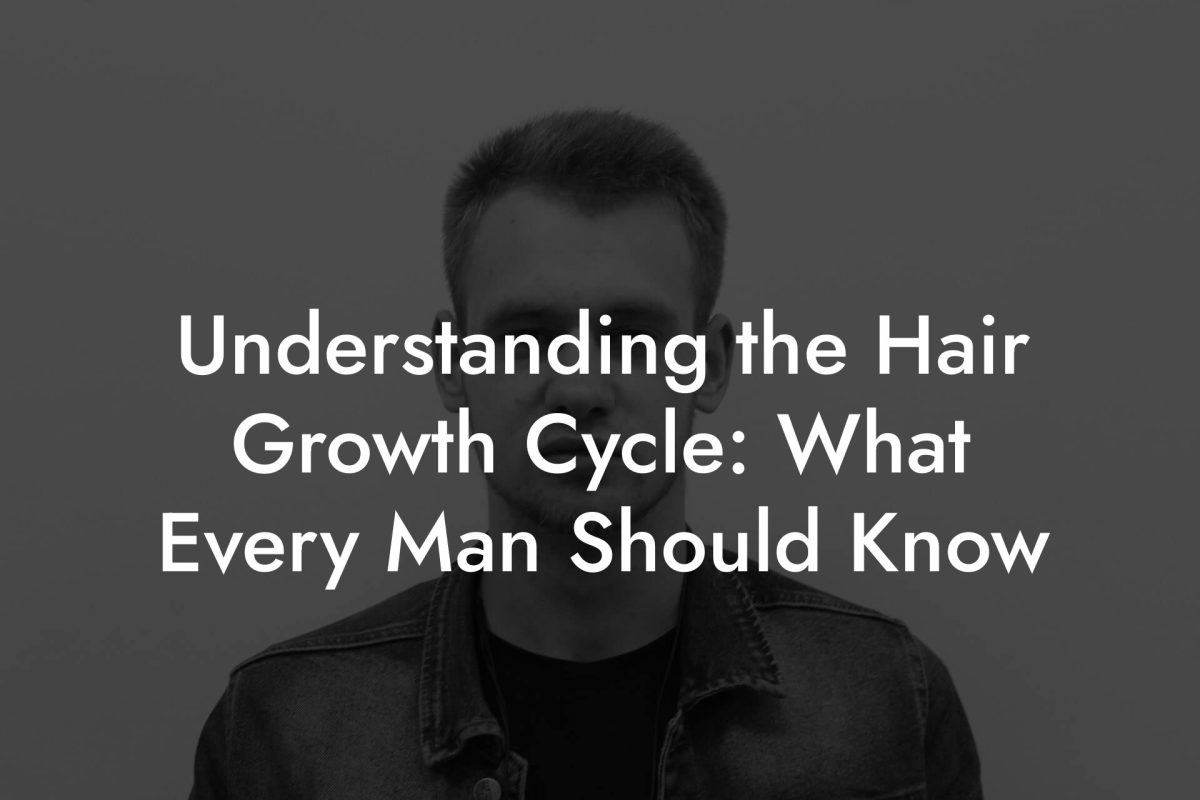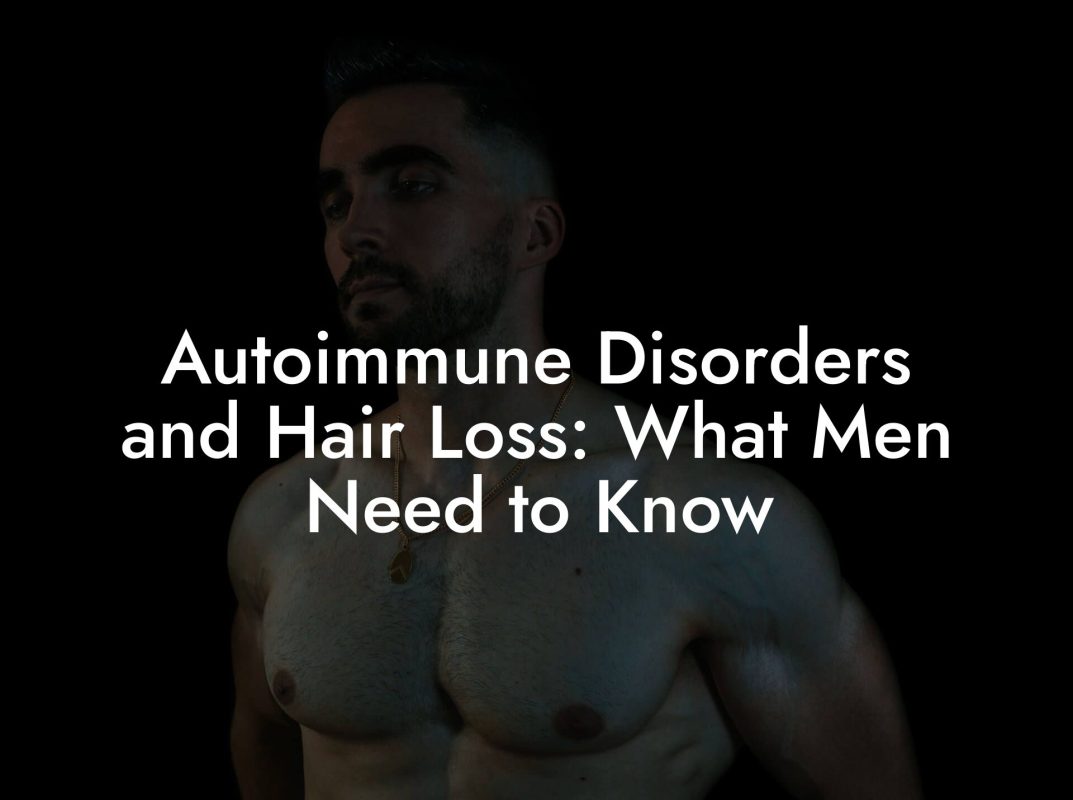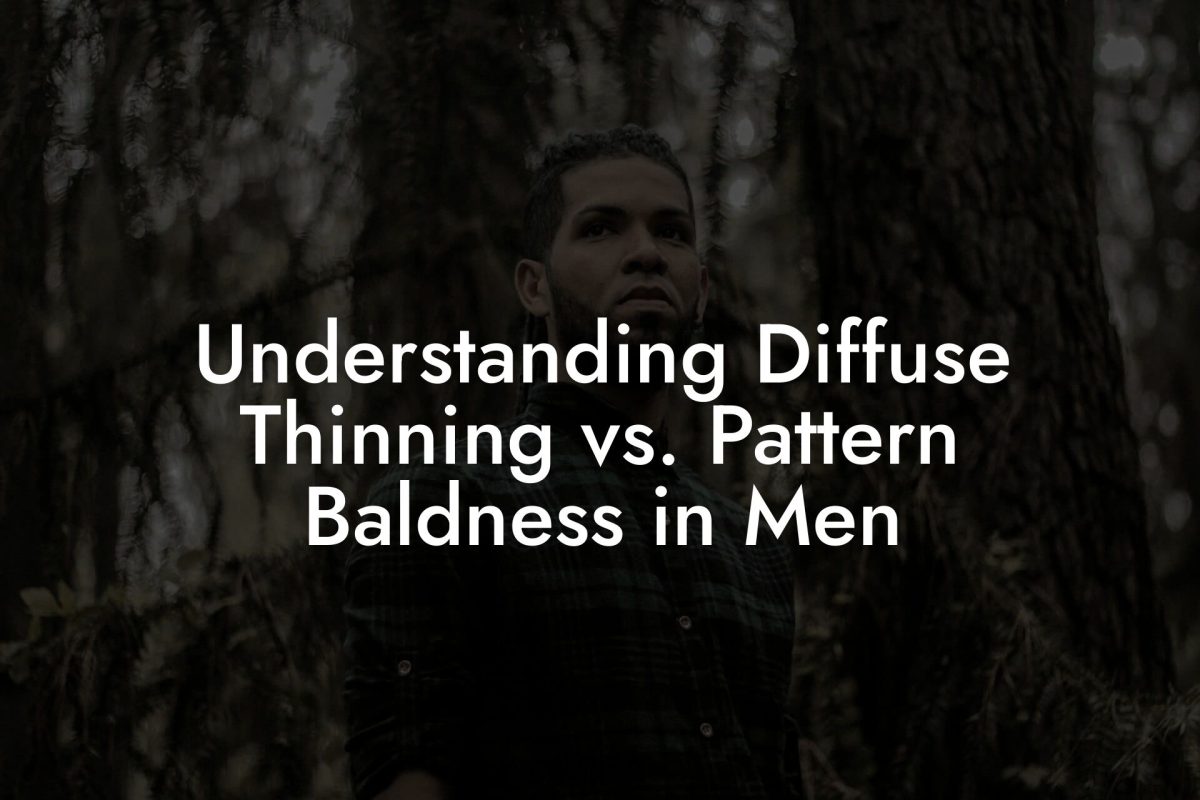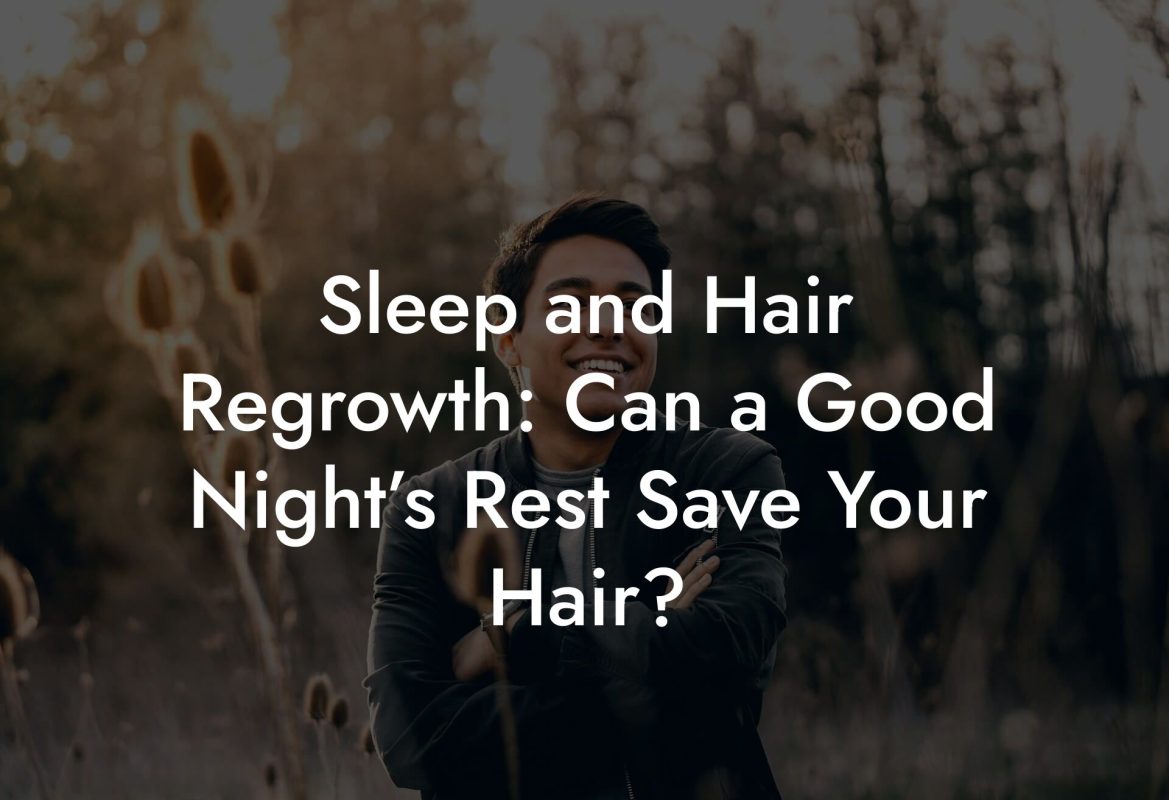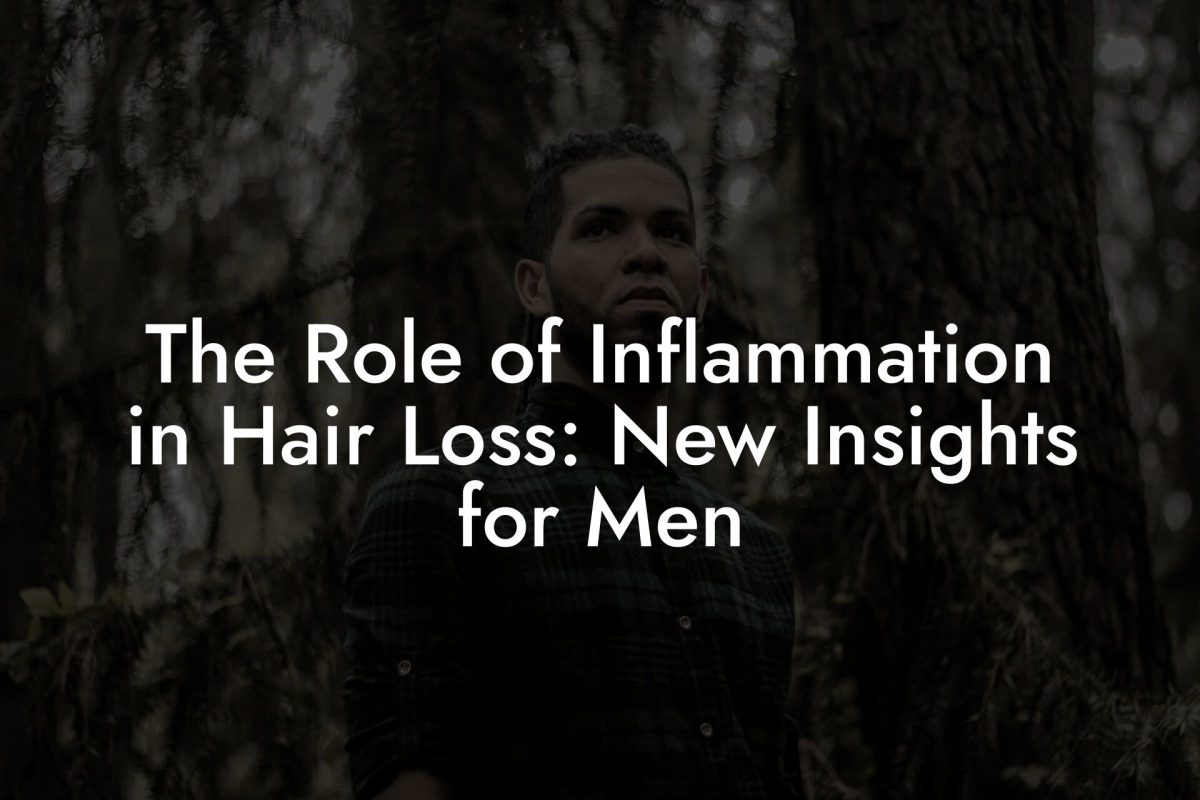Hair Loss Library
Spotting Early Signs: How to Identify Hair Loss Before It’s Too Late

Picture this: you’re getting ready for a big night out, and while checking your mirror, you notice something odd—a little extra scalp peek peeking out where there should be a full head of hair. Before your Instagram story turns into a full-blown rant about hair drama, let’s take a deep dive into how to spot those early signs of hair loss before it gets out of hand. Welcome to Mane Matrix’s guide to catching hair loss in its tracks—your no-nonsense, humorous, and thoroughly engaging roadmap to understanding your mane matters.
The Anatomy of a Great Head of Hair (And Why Losing It Isn’t FUN)
Hair is one of the most defining features of our appearance. It’s the crowning glory that compliments every mood from “I woke up like this” to what might have started as “bad hair day” and then escalates into “oops, where did it all go?” For many men, especially Millennials and Gen Z dudes who live under the glare of social media, thinning hair or a receding hairline can feel like a punch to the ego.
But why should you care about those stray hairs? Well, our hair isn’t just for looking fly—it acts as a natural protector against the sun and environmental nasties, and it’s historically been a key marker of youth and vitality. So, when early signs of hair loss start to show, it’s not just vanity; it’s about taking control and understanding what your body is trying to tell you.
At Mane Matrix, we know that dealing with hair loss doesn’t have to be a cold, clinical affair involving expensive consultations. Instead, think of this as your free, expert analysis guide that breaks down the science with a dash of wit and a whole lot of practical advice.
Understanding Hair Loss: More Than Just a Bad Hair Day
Let’s get one thing straight: hair loss is a multifaceted issue. It’s not just about losing strands from your scalp; it’s about understanding the story behind the loss. There are a host of reasons why your hair might be thinning, from genetics to lifestyle choices, and even the stress of trying to stay Insta-perfect.
In this section, we’ll explore what causes hair loss and how you can recognize the early signs before the premature baldness takes its toll on your self-confidence.
What Exactly Is Hair Loss?
Hair loss, medically known as alopecia, isn’t a one-size-fits-all phenomenon. There are several types:
- Androgenetic Alopecia: Often known as male pattern baldness, this is the most common type. It’s largely genetic, meaning if your dad or granddad had it, you might too.
- Alopecia Areata: An autoimmune condition where the body mistakenly attacks hair follicles.
- Telogen Effluvium: A temporary condition triggered by stress, illness, or nutritional deficiencies that pushes hair follicles into a resting phase, leading to noticeable shedding.
- Scarring Alopecia: A rarer form that involves permanent damage to hair follicles, often due to inflammation or other scalp conditions.
Knowing the type of hair loss you might be experiencing makes a big difference in how you approach treatment. Our journey isn’t just about panic-balding—it’s about understanding the clues your body is sending you.
The Early Warning Signs: Don't Let Your Hair Go AWOL
Early detection is key. Just like checking your bank account after a wild night out, a little vigilance can save you from a lot of regret later on. Here are the early signs you should be on the lookout for:
1. Excessive Shedding
We all lose hair—normally around 50 to 100 strands a day. But if you’re noticing clumps in your shower, on your pillow, or even in your favorite hat, it's time to take notice. Excessive shedding is one of the first red flags that something isn't right.
2. Thinning Around the Crown
A receding hairline might be the poster child of hair loss, but thinning isn't just about the hairline—often, it starts at the crown. If you notice your hair seems less dense up top, consider it an early alarm.
3. Changes in Hair Texture
Ever run your hand through your hair and felt strands that are finer or even brittle? Changes in texture can be early warning signs. Healthy hair should feel strong and resilient; if it feels like cotton candy, something’s off.
4. Visible Scalp
When you part your hair and see more scalp than hair, it can be disheartening. Gradual thinning might not scream “emergency,” but it’s definitely a sign you should pay attention to.
5. Itchy, Flaky Scalp
An itchy scalp isn’t always a sign of dandruff. Sometimes, those pesky flakes can be a symptom of underlying scalp conditions that contribute to hair loss. If your scalp feels more like a desert than a lush oasis, it may be time to investigate further.
Recognizing these signs early gives you the upper hand in deciding whether to change your lifestyle, tweak your diet, or explore treatments. The good news? You’ve caught this guide right in time.
The Science Behind the Shedding: What’s Going On in Your Scalp?
Though we’re keeping this fun and relatable, a little bit of science goes a long way. Hair growth occurs in cycles: the anagen (growth) phase, the catagen (transitional) phase, and the telogen (resting) phase. Disruptions to these cycles—whether through genetics, hormonal changes, or environmental stress—can prompt hair follicles to prematurely enter the resting phase, leading to shedding.
And let’s not forget about the role of androgens, especially dihydrotestosterone (DHT), which is infamous for contributing to male pattern baldness. If your follicles are super-sensitive to DHT, you might notice that gradual receding of the hairline or thinning of the crown.
It might sound complicated, but think of it this way: your scalp is like your favorite indie band trying to stay on top of trends. When the lead singer (your follicle) quits the band too early due to stress, hormones, or genetics, the vibe changes, and your hair starts ghosting you.
Common Culprits: What’s Causing Your Hair to Say “Bye-Bye”?
Let’s break down the usual suspects behind hair loss. Spoiler alert: it’s rarely just one thing. More often than not, it’s a combination of factors that push your follicles to pack up and leave.
Genetics: The Hand You’re Dealt
Genetics play a major role in male pattern baldness. If your father, grandfather, or even your cool uncle had hairline issues, there’s a good chance you might too. But remember—knowing your genetic predisposition isn’t a death sentence. It’s just one piece of the puzzle.
Hormonal Imbalances
Hormones are tricky business. When your testosterone converts to DHT, it might feel like your hair follicles are under a hostile takeover. This hormonal shift is a primary factor in male pattern baldness, and while you can’t exactly control your hormones with a snap of your fingers, there are ways to manage the effects.
Lifestyle and Stress
Modern life can be a whirlwind of deadlines, social media scrolling, and the constant pressure to “be on.” Chronic stress can lead to a condition known as telogen effluvium, where more hair than usual enters the resting phase. The result? Noticeable shedding and thinning over time.
Diet and Nutrition
You are what you eat— and so is your hair. A diet lacking in key nutrients like proteins, iron, vitamins (especially vitamin D and biotin), and omega-3 fatty acids can starve your hair follicles of the building blocks they need. On the flip side, a balanced diet helps promote healthy hair growth.
Environmental Factors
Pollution, UV exposure, and even harsh hair care products can damage the hair shaft and scalp, accelerating hair loss. The modern urban environment brings many challenges for maintaining healthy hair, so a little extra care goes a long way.
Medical Conditions and Medications
Certain health conditions—like thyroid disorders, autoimmune diseases, and even severe infections—can trigger hair loss. Additionally, medications ranging from blood thinners to antidepressants can have hair shedding as a side effect. Always consult with a healthcare professional if you suspect your medication might be affecting your hair health.
Understanding the multifactorial nature of hair loss equips you with the knowledge to make informed decisions about prevention and treatment. It’s never too early to start caring for your scalp like it’s the VIP section of your body.
Spotting the Subtle Signals: Early Signs You Can’t Ignore
Let’s get down to the details. Even if you don’t wake up to a full-blown bald spot tomorrow, there are subtle signals you might be missing. Here’s what to keep your eyes on:
1. A Gradually Receding Hairline
A receding hairline is often one of the first visual cues. If you notice the hairline pulling back a little each time you check in the mirror, it’s a sign that the forces of genetics and hormones might be at work.
2. Reduced Hair Volume
Run your fingers through your hair. Does it feel like there’s less volume than it used to be? Early thinning might not leave bald patches, but it can make your hair look limp and less lively. Think of it as your hair’s way of saying, “I need reinforcements.”
3. Mini “Patchwork” Areas
Sometimes hair loss starts in small, somewhat scattered areas before developing into more noticeable patches. These “patchwork” spots can be easy to miss if you’re not paying attention—so keep an eye out!
4. Changes in Scalp Health
A dry, itchy, or irritated scalp can be a sign that something is off. While it might be tempting to think you just need a better shampoo, these changes in scalp health could be early indicators of issues that contribute to hair loss.
Recognizing these subtle signals is your first defense. By spotting these early signs, you can take proactive steps to manage or even reverse the damage before it evolves into something more serious.
Practical Tips for Early Intervention: Taking Action Now
So, you’ve noticed a few of those red flags. What now? Lucky for you, early intervention can make all the difference. Here are some down-to-earth, actionable tips to help you combat hair loss before the situation escalates:
Revamp Your Hair Care Routine
Upgrade your shampoo and conditioner to products that are sulfate-free and enriched with nourishing ingredients like biotin, keratin, and essential fatty acids. Avoid harsh chemicals and frequent heat styling—your hair deserves the gentle care of someone who gets it.
Optimize Your Diet
What you eat directly influences your hair’s health. Load up on lean proteins, leafy greens, and foods rich in omega-3 fatty acids like salmon and walnuts. Vitamins and minerals such as zinc, iron, and vitamin D are your hair’s best friends. Consider consulting with a nutritionist if you’re not sure where to start.
Stress Less, Live More
Modern life is stressful, but chronic stress can wreak havoc on your body—and your hair. Incorporate stress-reduction techniques such as meditation, exercise, or even a good old-fashioned break from your phone. A relaxed mind can lead to a healthier scalp.
Scalp Massage: Small Action, Big Impact
A regular scalp massage not only feels great but also boosts blood circulation, delivering essential nutrients to your hair follicles. Use a nourishing oil like coconut or argan oil for added benefits.
Consider Over-the-Counter Solutions
There are several over-the-counter products designed to boost hair growth by targeting the hormonal factors at play. Look for products containing minoxidil or natural alternatives that can help fortify your follicles.
Remember, the earlier you take action, the better your chances of maintaining a robust mane. It’s all about creating a proactive routine that addresses both the external and internal factors affecting your scalp.
When to Seek Professional Advice: A Quick Guide
Not every stray hair or thinning patch spells doom, but there comes a point when professional insight is crucial. Here’s when you should definitely consider reaching out to a specialist:
- Rapid Hair Loss: If you notice a sudden spike in shedding or rapid changes in your hairline, it’s time to consult a dermatologist or a trichologist. Quick intervention can help nip potential issues in the bud.
- Persistent Scalp Issues: Ongoing itching, inflammation, or significant scalp irritation shouldn’t be ignored. These could be symptoms of underlying conditions such as psoriasis or dermatitis.
- Family History & Genetic Predisposition: If you have a strong family history of male pattern baldness and you’re starting to see similar patterns, getting a professional evaluation will set you on the right track.
- Uncertainty Over Treatment Options: The world of hair loss treatments is packed with do-it-yourself remedies and miracle cures. A professional evaluation can help you navigate safely through the maze of options to find what truly works.
At Mane Matrix, our approach is to provide you with expert analysis that cuts out the fluff. We’re all about delivering insights rooted in science, without having you endure expensive and embarrassing consultations. Know your limits and trust professional advice when the signals become too pronounced.
Technological Tools and Modern Solutions: Your Hair’s New Best Friends
In today’s digital world, technology isn’t just for social media and streaming—it’s revolutionizing how we approach hair care. From smartphone apps that track your hair’s progress to innovative devices that stimulate your scalp, there are modern solutions designed to give your mane the best possible future.
Imagine a device that uses gentle LED light therapy to stimulate hair follicles and improve circulation. Or an app that lets you document your hair’s progress with regular photos and offers tips based on your unique hair pattern. These tools not only empower you to monitor changes but also help you adjust your routine as you notice improvements—or setbacks.
Plus, there’s an entire online community of men sharing their hair loss journeys, tips, and even quirky hair care routines. With a little digital detective work, you can connect with others, share success stories, and learn about the latest breakthroughs in hair loss research.
Debunking Hair Loss Myths: What’s Fact and What’s Fiction?
The internet is rife with myths about hair loss—think miracle shampoos, supernatural hair regrowth potions, and miracle diets. It’s time to set the record straight:
- Myth 1: Washing Your Hair Too Often Causes Baldness. Fact: Regular washing keeps the scalp healthy by removing excess oil and dirt. It’s not the frequency, but the harshness of the products that can sometimes cause issues.
- Myth 2: Stress Is the Sole Cause of Hair Loss. Fact: While stress can trigger temporary shedding, long-term hair loss is more complex and usually a mix of genetics, hormones, diet, and lifestyle habits.
- Myth 3: There’s a "Cure" for Hair Loss Overnight. Fact: Hair growth cycles take time to change. Most effective treatments require consistent effort over months to see real progress.
- Myth 4: Only Expensive Medical Procedures Can Save Your Hair. Fact: Many preventative measures and over-the-counter treatments, combined with lifestyle changes, can make a significant impact if you catch the signs early.
By dispelling these myths, you can focus on evidence-based approaches rather than chasing after instant fixes. Knowledge is power, especially when it comes to your hair.
Real Talk: How Men Are Navigating Hair Loss in the Modern Age
Let’s be honest—navigating hair loss in today’s world can be daunting. Between grooming trends, filter-enhanced selfies, and the ever-present pressure of looking your best, it’s easy to feel overwhelmed. But here’s the silver lining: you’re definitely not alone.
Across the globe, men are taking proactive steps to understand and manage their hair loss. Whether it’s joining online forums, following trusted influencers who share their journeys, or simply experimenting with different hair care routines, you’re part of a growing movement that refuses to let thinning hair define your identity.
In many ways, the journey towards a healthier mane is like leveling up in your favorite video game. It takes strategy, persistence, and sometimes, a little bit of experimentation. And at Mane Matrix, we’re here to provide you with the cheat codes—scientific insights, practical tips, and a community that gets it.
Real-Life Story: From “Balding Bloke” to Mane Master
Consider Jake, a 29-year-old graphic designer who first noticed a receding hairline just as he was stepping into a leadership role at work. Instead of letting it derail his confidence, he dove into research, revamped his hair care routine, adjusted his diet, and started using a light therapy cap. His journey wasn’t overnight magic, but over the course of a year, Jake not only halted further loss, he saw a noticeable improvement in hair density. His story reminds us that proactive choices can turn the tide, even when the odds seem stacked.
These narratives are proof that with the right mindset and tools, you can face hair loss head-on. Embrace the process, experiment smartly, and remember: every strand counts.
Resources and Community Support: Your Next Steps
No man is an island, especially when it comes to something as personal as hair loss. Here at Mane Matrix, we believe that professional advice combined with community support is a winning combo. Whether you’re looking for one-on-one expert analysis or just some relatable advice from fellow hair warriors, there are plenty of resources available.
Join Online Forums and Social Groups: Dive into communities where men share their journeys, exchange tips, and provide moral support. Social media groups and dedicated forums can be incredibly empowering.
Subscribe to Trusted Newsletters and Blogs: Keep up-to-date with the latest research on hair loss treatments, styling tips, and technological breakthroughs in hair care. Knowledge is power, and staying informed can guide your decisions.
Consult with a Hair Loss Specialist: If you feel your hair loss is progressing or if you have questions about potential treatments, it might be time to get a professional evaluation. With expert insights from Mane Matrix, you can bypass the embarrassment and expense of traditional consultations.
Try Out Hair Improvement Apps and Tools: Leverage technology by trying out smartphone apps that track hair progress. Many of these tools come with personalized recommendations that help you stay on course.
Connecting with others not only helps you stay accountable but also offers the comfort of knowing you’re in good company on this journey. Every struggle has its shared success stories, and your journey is just beginning.
Your Roadmap to a Fuller Future: Crafting a Personalized Action Plan
Now that you’re armed with the know-how on spotting early signs of hair loss, it’s time to put together a personalized action plan that works for you. Consider the following steps as your roadmap to maintaining a healthy, confident head of hair:
Step 1: Monitor and Document Your Hair Journey
Start by taking regular photos of your hair. This isn’t for Instagram perfection but to track subtle changes over time. Notes on shedding patterns, scalp health, and even stress levels can help you understand triggers and progress.
Step 2: Revise Your Hair Care Routine
Reevaluate your daily rituals—switch to gentler cleansing products, incorporate a nourishing conditioner, and consider weekly scalp massages or treatments that promote circulation. Experiment until you find what makes your hair feel rejuvenated.
Step 3: Upgrade Your Diet
Make nutritional adjustments that benefit hair health. Increase your intake of proteins, vitamins (like biotin and vitamin D), and omega-3 fatty acids. Even small tweaks can have a big impact on how strong and resilient your hair feels.
Step 4: Integrate Stress-Reduction Techniques
Whether it’s yoga, meditation, jogging, or simply taking a break from digital overload, incorporating stress management into your routine will not only benefit your overall health but also create a more favorable environment for hair growth.
Step 5: Stay Informed and Connected
Subscribe to reliable sources, join supportive communities, and consider occasional professional check-ups to ensure you’re on track. The more informed and supported you are, the better you can tailor your approach.
This personalized roadmap is designed to empower you. Remember, every small step you take contributes to a fuller, healthier future—one strand at a time.
Integrating Modern Trends With Timeless Advice: Embrace Your Journey
The beauty of today’s world is that you don’t have to choose between traditional wisdom and modern innovation. Combining time-tested hair care practices with the latest technological advances creates a holistic approach that’s perfect for navigating hair loss in the 21st century.
Think of it as curating a wardrobe of hair care—some pieces are classic and timeless, while others are bold, trendsetting additions that keep you on the cutting edge. In any case, your journey is as unique as your hairstyle should be, and embracing this blend of old and new is the secret to lifelong confidence.
So, whether you’re tweaking your diet, trying out a new hair growth serum, or simply learning to rock a stylish, effortless look, know that you’re in command. Your mane tells a story, and you have every right to make sure it’s a narrative of strength, resilience, and authenticity.
FAQs About Spotting Early Signs of Hair Loss
We know you might still have questions. Here are some of the most frequently asked questions by men in their 20s and 30s who are navigating the early signs of hair loss:
1. What are the earliest signs of hair loss I should look out for?
Early signs include excessive shedding (noticeable clumps of hair in your shower or on your pillow), a gradually receding hairline, thinning around the crown, and a visible scalp when combing or styling. Additionally, changes in hair texture and scalp health, such as increased dryness or itchiness, can be early signals.
2. How can I tell if my hair loss is genetic?
If you have a family history of male pattern baldness—say, your dad or granddad dealt with similar issues—it’s a strong indicator that genetics may be playing a significant role. However, factors like stress and diet can also contribute, so it’s wise to consider all angles.
3. Can lifestyle changes really make a difference in preventing further hair loss?
Absolutely! Adjusting your diet, managing stress, and improving your hair care routine can all contribute to better hair health and may slow the progression of hair loss.
4. Are over-the-counter treatments effective for early hair loss?
Many men report success with over-the-counter products such as minoxidil-based solutions and specialized shampoos when used consistently early on. Consulting with a specialist can help tailor these options to your needs.
5. How long does it usually take to notice improvements after changing my hair care routine?
Hair growth is a slow process. Typically, it may take several months before you see noticeable improvements. Patience and consistency are key.
6. Can stress really cause hair loss, or am I just overthinking it?
Chronic stress can trigger a condition known as telogen effluvium, which leads to temporary hair shedding. Managing stress through exercise, meditation, or even a digital detox can have a positive impact on your hair’s health.
7. Should I consider professional help if I start noticing early signs of hair loss?
If you’re noticing rapid changes or persistent issues, it’s a good idea to consult with a dermatologist or trichologist who can provide a personalized evaluation and suggest effective treatments.
8. Does using heat styling tools contribute to early hair loss?
Excessive use of heat styling tools can damage your hair, making it more prone to breakage and thinning over time. Moderation and using protective products can help minimize the risk.
9. How do modern technological tools help in managing hair loss?
From LED therapy caps to smartphone apps that track your hair progress, technology offers innovative ways to monitor and stimulate hair growth, making it easier to adjust your routine based on real-time feedback.
10. Can I completely reverse early hair loss, or do I just need to manage it?
While reversing hair loss entirely can be challenging, especially if genetic factors are strong, early intervention and a proactive approach can significantly slow down or even partially reverse the process.
Your Journey to Embracing a Healthier Mane Starts Now
At the end of the day, hair loss is not just about what you see in the mirror—it’s about taking control of your overall well-being. By recognizing early signs and implementing proactive strategies, you’re investing in a future where you call the shots when it comes to your hair health.
Whether you choose to overhaul your hair care routine, embrace a healthier lifestyle, or simply stay informed by tapping into expert advice from Mane Matrix, the power is in your hands. Remember, a great head of hair isn’t just inherited—it’s nurtured, maintained, and celebrated every single day.
Your journey might have its ups and downs, but with the right information and a supportive community, you can face hair loss head-on with a confident smile. So, keep those early signs in check, take actionable steps, and celebrate every little victory along the way. After all, every strand of progress counts!
If you loved this article... Dive deeper into the world of mens hair loss with our most popular sections. If there is anything you think is missing or anything you would love for us to write about, just give us a shout.
Why Am I Losing Hair? Unpacking the Science Behind Men’s Hair Loss
The Ultimate Guide to Male Pattern Baldness: Causes and Clues
Hormones & Hair: How Testosterone Impacts Hair Loss in Men
Genetics vs. Lifestyle: What’s Really Causing Your Hair Loss?
Stress and Strands: Exploring the Link Between Anxiety and Hair Loss
Decoding Androgenetic Alopecia: What Every Man Needs to Know
How Aging Affects Your Hair: Understanding the Natural Process
The Role of Diet in Hair Health: Nutrients That Prevent Hair Loss
Environmental Factors: How Pollution and Toxins Trigger Hair Loss
Medical Conditions and Hair Loss: What’s Normal and What’s Not?
The Impact of Medications on Men’s Hair: What You Should Ask Your Doctor
Unraveling Scalp Health: Signs Your Scalp Needs Extra Care
Hair Loss Myths Busted: Separating Fact from Fiction
The Role of Inflammation in Hair Loss: New Insights for Men
Sleep and Hair Regrowth: Can a Good Night’s Rest Save Your Hair?
How Smoking and Alcohol Affect Men’s Hair: A Deep Dive
Understanding Diffuse Thinning vs. Pattern Baldness in Men
Innovative Research: The Future of Hair Loss Studies for Men
Spotting Early Signs: How to Identify Hair Loss Before It’s Too Late
Autoimmune Disorders and Hair Loss: What Men Need to Know
The Science Behind Hair Follicle Miniaturization Explained
How Your Lifestyle Choices Impact Your Hair’s Future
Understanding the Hair Growth Cycle: What Every Man Should Know
When to Worry: Recognizing Abnormal Hair Loss Patterns in Men
The Intersection of Genetics and Environment in Male Hair Loss






